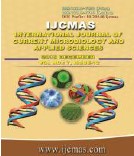


 National Academy of Agricultural Sciences (NAAS)
National Academy of Agricultural Sciences (NAAS)

|
PRINT ISSN : 2319-7692
Online ISSN : 2319-7706 Issues : 12 per year Publisher : Excellent Publishers Email : editorijcmas@gmail.com / submit@ijcmas.com Editor-in-chief: Dr.M.Prakash Index Copernicus ICV 2018: 95.39 NAAS RATING 2020: 5.38 |
The investigations on Nectar secretion rhythms and nectar energetics of Trifolium alexandrinum flowers were carried at Forage Section, Department of Genetics and Plant Breeding, CCS, Haryana Agricultural University, Hisar during 2012 and 2013. A T. alexandrinum flower produced a mean dry nectar sugars (DNS) of 1.95 mg and its amount in 2013 was higher (2.168 mg/flower) than 2012 (1.734 mg). Physiologically mature flower (fully opened) produced maximum amount of DNS (2.453 mg) followed by half (1.900) and just opened flowers (1.500 mg). The maximum DNS (2.027 mg) was produced at 1300 h followed by at 1000 and 1600 h (1.926 and 1.900 mg, respectively) which were at par with each other. The fully opened flowers produced maximum DNS at all the observed time intervals of 1000, 1300 and 1600 h (2.468, 2.446 and 2.444 mg/flower, respectively) followed by half opened flowers in the afternoon hours of 1300 and 1600 h (1.947 and 1.921 mg, respectively) while it was lower in the morning hours at 1.832 mg.
 |
 |
 |
 |
 |